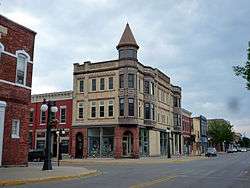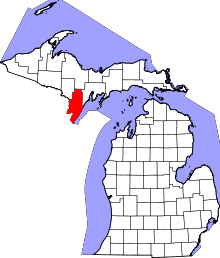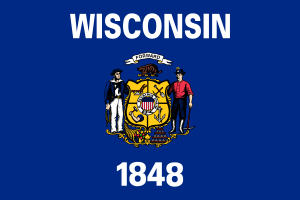Menominee, Michigan
| Menominee, Michigan | |
|---|---|
| City | |
|
The Historical Waterfront Downtown is listed on the National Register of Historic Places as the First Street Historic District. | |
 Location in the state of Michigan | |
| Coordinates: 45°6′28″N 87°36′51″W / 45.10778°N 87.61417°WCoordinates: 45°6′28″N 87°36′51″W / 45.10778°N 87.61417°W | |
| Country | United States |
| State | Michigan |
| County | Menominee |
| Government | |
| • Mayor | Jean Stegeman |
| Area[1] | |
| • Total | 5.48 sq mi (14.19 km2) |
| • Land | 5.15 sq mi (13.34 km2) |
| • Water | 0.33 sq mi (0.85 km2) |
| Elevation | 594 ft (179 m) |
| Population (2010)[2] | |
| • Total | 8,599 |
| • Estimate (2012[3]) | 8,502 |
| • Density | 1,669.7/sq mi (644.7/km2) |
| Time zone | CST (UTC-6) |
| • Summer (DST) | CDT (UTC-5) |
| ZIP code | 49858 |
| Area code(s) | 906 |
| FIPS code | 26-53020[4] |
| GNIS feature ID | 0632104[5] |
| Website | http://www.cityofmenominee.org/ |
Menominee is a city in the Upper Peninsula of the U.S. state of Michigan. The population was 8,599 at the 2010 census. It is the county seat of Menominee County.[6] Menominee is the fourth-largest city in the Upper Peninsula, behind Marquette, Sault Ste. Marie, and Escanaba. Menominee Township is located to the north of the city, but is politically autonomous.
Menominee is part of the Marinette, WI–MI Micropolitan Statistical Area.
History
Menominee was named after a regional Native American tribe known as the Menominee, whose name roughly translates into "wild rice," which they cultivated as a staple food.[7] In historic times, this area was the traditional territory of the Menominee Indian Tribe. They were removed to west of the Mississippi River and now have a reservation along the Wolf River in North Central Wisconsin.
Menominee gained prominence in the 19th century as a lumber town; in its heyday, it produced more lumber than any other city in the United States of America. During this time of prosperity, the Menominee Opera House was built. It is being restored.[8] In the 1910s a cycle car, the "Dudly Bug", was manufactured in Menominee. In the waning years of lumber production, local business interests, interested in diversifying Menominee's manufacturing base, attracted inventor Marshall Burns Lloyd and his Minneapolis company Lloyd Manufacturing, which made wicker baby buggies. In 1917 Lloyd invented an automated process for weaving wicker and manufactured it as the Lloyd Loom. This machine process is still in use today.[9] In the 21st century, the economy of Menominee is based on manufacturing (paper products, wicker lawn furniture, and auto supplies) and tourism.
In 1940, during the "Vote for Gracie" publicity stunt in which comedian Gracie Allen ran for President, she was nominated for mayor of Menominee, but was disqualified because she was not a resident of the city.[10]
The Menominee Maroons won the state high school championship in its division for basketball in 1967 and football in 1998, 2006 and 2007. In the 2006 season the Maroons finished unbeaten and only allowed 38 points scored against them but their offense scored 513 point in that entire season . They beat the former Wisconsin and Minnesota Division One state champions. Menominee shares a historic high school football rivalry with neighbor Marinette, Wisconsin. The two have conducted the third longest rivalry in the nation.[11]
Geography

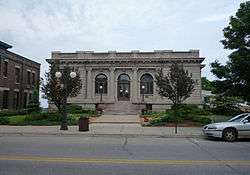
According to the United States Census Bureau, the city has a total area of 5.48 square miles (14.19 km2), of which 5.15 square miles (13.34 km2) is land and 0.33 square miles (0.85 km2) is water.[1] It is the southernmost city and location in Michigan's Upper Peninsula.
Menominee has a cairn marking the halfway point between the North Pole and the Equator. This is slightly north of the 45th parallel north, due to the flattening of the earth at the poles. This is one of six Michigan sites and 29 places in the U.S.A. where such signs are known to exist.[12]
Menominee, Michigan, is also the site of the Menominee Crack, an unusual geological feature that formed spontaneously in 2010.
Climate
This climatic region is typified by large seasonal temperature differences, with warm to hot (and often humid) summers and cold (sometimes severely cold) winters. According to the Köppen Climate Classification system, Menominee has a humid continental climate, abbreviated "Dfb" on climate maps.[13]
Twin city with Marinette, Wisconsin
Menominee and Marinette, Wisconsin are sometimes described as "twin cities". Menominee shares a hospital, community foundation, newspaper and chamber of commerce with Marinette. Numerous city groups work together to benefit the entire, two-city, two-county and two state community.
Demographics
| Historical population | |||
|---|---|---|---|
| Census | Pop. | %± | |
| 1870 | 1,597 | — | |
| 1880 | 3,288 | 105.9% | |
| 1890 | 10,630 | 223.3% | |
| 1900 | 12,818 | 20.6% | |
| 1910 | 10,507 | −18.0% | |
| 1920 | 8,907 | −15.2% | |
| 1930 | 10,320 | 15.9% | |
| 1940 | 10,230 | −0.9% | |
| 1950 | 11,151 | 9.0% | |
| 1960 | 11,289 | 1.2% | |
| 1970 | 10,748 | −4.8% | |
| 1980 | 10,099 | −6.0% | |
| 1990 | 9,398 | −6.9% | |
| 2000 | 9,131 | −2.8% | |
| 2010 | 8,599 | −5.8% | |
| Est. 2015 | 8,382 | [14] | −2.5% |
2010 census
As of the census[2] of 2010, there were 8,599 people, 3,987 households, and 2,311 families residing in the city. The population density was 1,669.7 inhabitants per square mile (644.7/km2). There were 4,456 housing units at an average density of 865.2 per square mile (334.1/km2). The racial makeup of the city was 96.7% White, 0.4% African American, 0.9% Native American, 0.5% Asian, 0.2% from other races, and 1.2% from two or more races. Hispanic or Latino of any race were 1.4% of the population.
There were 3,987 households of which 26.3% had children under the age of 18 living with them, 40.0% were married couples living together, 12.6% had a female householder with no husband present, 5.4% had a male householder with no wife present, and 42.0% were non-families. 37.1% of all households were made up of individuals and 14.5% had someone living alone who was 65 years of age or older. The average household size was 2.13 and the average family size was 2.74.
The median age in the city was 44 years. 21.8% of residents were under the age of 18; 7% were between the ages of 18 and 24; 22.7% were from 25 to 44; 30.3% were from 45 to 64; and 18.3% were 65 years of age or older. The gender makeup of the city was 48.7% male and 51.3% female.
2000 census
As of the census[4] of 2000, there were 9,131 people, 4,063 households, and 2,441 families residing in the city. The population density was 1,763.2 per square mile (680.6/km²). There were 4,393 housing units at an average density of 848.3 per square mile (327.4/km²). The racial makeup of the city was 97.35% White, 0.14% African American, 0.82% Native American, 0.32% Asian, 0.27% from other races, and 1.10% from two or more races. Hispanic or Latino of any race were 1.12% of the population. 31.6% were of German, 9.3% French, 8.7% Swedish, 8.7% Polish, 7.2% Irish and 6.7% French Canadian ancestry according to Census 2000.
There were 4,063 households out of which 27.9% had children under the age of 18 living with them, 43.6% were married couples living together, 12.4% had a female householder with no husband present, and 39.9% were non-families. 35.3% of all households were made up of individuals and 15.0% had someone living alone who was 65 years of age or older. The average household size was 2.22 and the average family size was 2.86.
In the city the population was spread out with 23.9% under the age of 18, 9.4% from 18 to 24, 25.8% from 25 to 44, 22.8% from 45 to 64, and 18.2% who were 65 years of age or older. The median age was 39 years. For every 100 females there were 92.8 males. For every 100 females age 18 and over, there were 90.4 males.
The median income for a household in the city was $30,523, and the median income for a family was $38,867. Males had a median income of $32,850 versus $22,145 for females. The per capita income for the city was $17,500. About 9.9% of families and 13.3% of the population were below the poverty line, including 18.2% of those under age 18 and 11.9% of those age 65 or over.
Historic downtown and marina
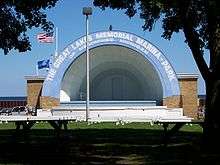
Much of Menominee's L-shaped downtown runs along the shores of the bay of Green Bay and includes the Great Lakes Memorial Marina and park. Many of the downtown buildings, built at the end of the 19th century or the beginning of the 20th, have been restored. They now provide space for several upscale restaurants, gift shops, beauty salons and day spas, antiques shops, galleries and a variety of essential services. The Menominee Bandshell is a focal point for concerts, an art show, a car show and a four-day community festival.
Economy
The greater Menominee area is home to a variety of industries, including shipbuilding, auto parts, chemicals, helicopter design and construction, airplane components, health care, and paper making. In good financial times, some local companies have reported a shortage of skilled workers.
The types of jobs available locally include assemblers, assembly coordinators, building and grounds technicians, custodians, cutting machine operators, electricians, fabrication operators, fixture technicians, journeyman toolmakers, machinists, maintenance mechanics, material handlers, metal fabricators, forklift drivers, paint coordinators, powder coating specialists, research-and-development technicians, quality control technicians, sewing and weaving machine operators, shipping/loading/receiving attendants, spinning and rewind machine operators, cutters, stamping operators, welders, and welding coordinators.
Transportation
Major highways
-
 US 41 connects with Escanaba and Marquette to the north and Marinette, Wisconsin and Green Bay, Wisconsin to the south.
US 41 connects with Escanaba and Marquette to the north and Marinette, Wisconsin and Green Bay, Wisconsin to the south. -
 M-35 runs northeast to provide a more direct route to Escanaba along the shore of Lake Michigan's Green Bay.
M-35 runs northeast to provide a more direct route to Escanaba along the shore of Lake Michigan's Green Bay. -
 WIS 64 starts just across the state line in Marinette and travels westerly.
WIS 64 starts just across the state line in Marinette and travels westerly. -
 WIS 180 starts just across the state line in Marinette and travels northerly then westerly.
WIS 180 starts just across the state line in Marinette and travels northerly then westerly. - Indian Trails bus lines operates daily intercity bus service between Hancock and Milwaukee, WI with a stop in Menominee.[16]
Airport
Menominee is serviced by the Menominee-Marinette Twin County Airport (KMNM)
Recreation
Menominee's waterfront is the setting for public events in the summer, including a city-sponsored festival. The Marinette Menominee Area Chamber of Commerce coordinates a concert series held on Thursdays from late June to mid-August. The Cabela Master Walleye Circuit brought hundreds of fishermen and women to the area for tournaments in 2005, 2008 and 2009.
Notable people
- James Bonk, longtime chemistry professor, Duke University
- John O. Henes, businessman and philanthropist
- Kathleen Kirkham, silent-film actress
- Mitchell Leisen, Hollywood director, art director and costumer designer
- Dave Mason, NFL player
- Richard P. Matty, Wisconsin State Assemblyman
- John McLean, Olympic silver medal winner
- Alvin H. Nielsen, molecular spectroscopist
- Harald Herborg Nielsen, physicist
- William Nolde, last American soldier killed in Vietnam
- Fred Stephenson Norcross, University of Michigan football captain, coach Oregon State University
- Doris Packer, actress (played Mrs. Rayburn, Theodore Cleaver's principal in the television series Leave It to Beaver)
- Bill Rademacher, NFL player, Super Bowl III champion
- Samuel M. Stephenson, member of United States House of Representatives from Michigan
- Bart Stupak, member of US House of Representatives from Michigan
See also
References
- 1 2 "US Gazetteer files 2010". United States Census Bureau. Retrieved 2012-11-25.
- 1 2 "American FactFinder". United States Census Bureau. Retrieved 2012-11-25.
- ↑ "Population Estimates". United States Census Bureau. Retrieved 2013-06-03.
- 1 2 "American FactFinder". United States Census Bureau. Retrieved 2008-01-31.
- ↑ U.S. Geological Survey Geographic Names Information System: Menominee, Michigan
- ↑ "Find a County". National Association of Counties. Retrieved 2011-06-07.
- ↑ Chicago and North Western Railway Company (1908). A History of the Origin of the Place Names Connected with the Chicago & North Western and Chicago, St. Paul, Minneapolis & Omaha Railways. p. 101.
- ↑ Menominee Opera House
- ↑ "Marshall Burns Lloyd articles". mlloyd.org.
- ↑ Epstein, Lawrence J. (February 22, 2012). "Gracie Allen for President". Best American Poetry.
- ↑ "ByeLines by Larry Ebsch: M&M Game spirit can't be beat"; September 10, 2006; Eagle Herald; Retrieved September 10, 2007
- ↑ "45th Parallel North America". wurlington-bros.com.
- ↑ "Menominee, Michigan Köppen Climate Classification (Weatherbase)". Weatherbase.
- ↑ "Annual Estimates of the Resident Population for Incorporated Places: April 1, 2010 to July 1, 2015". Retrieved July 2, 2016.
- ↑ "Census of Population and Housing". Census.gov. Retrieved June 4, 2015.
- ↑ "Hancock-Marquette-Green Bay-Milwaukee" (PDF). Indian Trails. January 12, 2012. Retrieved 2013-02-27.
 Welcome sign
Welcome sign Marina
Marina US 41 in Menominee
US 41 in Menominee
External links
| Wikimedia Commons has media related to Menominee, Michigan. |
- Official City Website
- Menominee's Historic Waterfront Downtown
- Menominee Public Library
- Menominee Public Schools
- Marinette Menominee Area Chamber of Commerce
